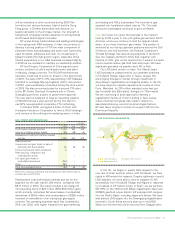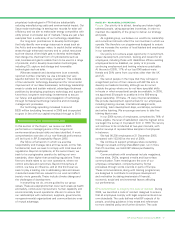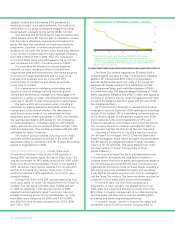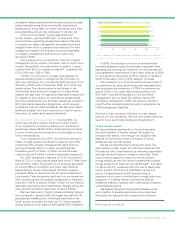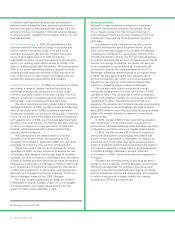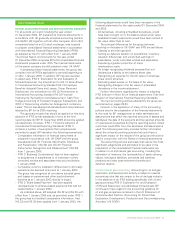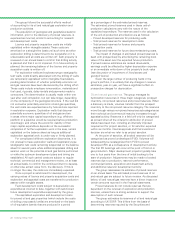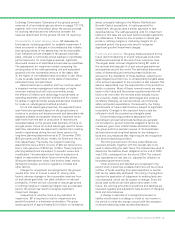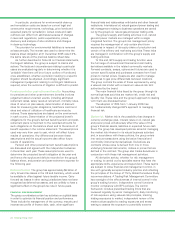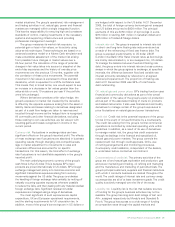BP 2005 Annual Report Download - page 27
Download and view the complete annual report
Please find page 27 of the 2005 BP annual report below. You can navigate through the pages in the report by either clicking on the pages listed below, or by using the keyword search tool below to find specific information within the annual report.
BP Annual Report and Accounts 2005 25
are hedged with respect to the US dollar. At 31 December
2005, the total of foreign currency borrowings not swapped
into US dollars amounted to $424 million. The principal
elements of this are $150 million of borrowings in euros,
$76 million in sterling, $81 million in Canadian dollars and
$83 million in Trinidad & Tobago dollars.
Interest rate risk The group is exposed to interest rate risk
on short- and long-term floating rate instruments and as
a result of the refinancing of fixed rate finance debt. The
group is exposed predominantly to US dollar LIBOR
(London Inter-Bank Offer Rate) interest rates as borrowings
are mainly denominated in, or are swapped into, US dollars.
To manage the balance between fixed and floating rate
debt, the group enters into interest rate and cross-currency
swaps in which the group agrees to exchange, at specified
intervals, the difference between fixed and variable rate
interest amounts calculated by reference to an agreed
notional principal amount. The proportion of floating rate
debt at 31 December 2005 was 96% of total finance
debt outstanding.
Oil, natural gas and power prices BP’s trading function uses
financial and commodity derivatives as part of the overall
optimization of the value of the group’s equity oil production
and as part of the associated trading of crude oil, products
and related instruments. It also uses financial and commodity
derivatives to manage certain of the group’s exposures to
price fluctuations on natural gas and power transactions.
Credit risk Credit risk is the potential exposure of the group
to loss in the event of non-performance by a counterparty.
The credit risk arising from the group’s normal commercial
operations is controlled by individual operating units within
guidelines. In addition, as a result of its use of derivatives
to manage market risk, the group has credit exposures
through its dealings in the financial and specialized oil,
natural gas and power markets. The group controls the
related credit risk through credit approvals, limits, use
of netting arrangements and monitoring procedures.
Counterparty credit validation, independent of the dealers,
is undertaken before contractual commitment.
Concentrations of credit risk The primary activities of the
group are oil and natural gas exploration and production, gas
and power marketing and trading, oil refining and marketing
and the manufacture and marketing of petrochemicals. The
group’s principal customers, suppliers and financial institutions
with which it conducts business are located throughout the
world. The credit ratings of interest rate and currency swap
counterparties are all of at least investment grade. The credit
quality is actively managed over the life of the swap.
Liquidity risk Liquidity risk is the risk that suitable sources
of funding for the group’s business activities may not be
available. The group has long-term debt ratings of Aa1 and
AA+, assigned respectively by Moody’s and Standard &
Poor’s. The group has access to a wide range of funding
at competitive rates through the capital markets and
market situations. The group’s operational, risk management
and trading activities in oil, natural gas, power and financial
markets are managed within a single integrated function.
This has the responsibility for ensuring high and consistent
standards of control, making investments in the necessary
systems and supporting infrastructure and providing
professional management oversight.
The group measures its market risk exposure, i.e.
potential gain or loss in fair values, on its activity using
value-at-risk techniques. These techniques are based on a
variance/covariance model or a Monte Carlo simulation and
make a statistical assessment of the market risk arising
from possible future changes in market values over a
24-hour period. The calculation of the range of potential
changes in fair value takes into account a snapshot of the
end-of-day exposures and the history of one-day price
movements over the previous 12 months, together with
the correlation of these price movements. The potential
movement in fair values is expressed to three standard
deviations, which is equivalent to a 95% confidence level.
This means that, in broad terms, one would expect to see
an increase or a decrease in fair values greater than the
value-at-risk on only 10 occasions per year if the portfolio
were left unchanged.
Where derivatives constitute a fair value hedge, the
group’s exposure to market risk created by the derivative
is offset by the opposite exposure arising from the asset or
liability. Gains and losses relating to derivatives designated
as part of a cash flow hedge are taken to reserves and
recycled through income as the hedged item is recognized.
All commodity and other financial derivatives, excluding
those relating to own use activities, are fair valued, with
resulting gains and losses recognized in income in the
current period.
Currency risk Fluctuations in exchange rates can have
significant effects on the group’s reported profit. The effects
of most exchange rate fluctuations are absorbed in business
operating results through changing cost-competitiveness,
lags in market adjustment to movements in rates and
conversion differences accounted for on specific
transactions. For this reason, the total effect of exchange
rate fluctuations is not identifiable separately in the group’s
reported profit.
The main underlying economic currency of the group’s
cash flows is the US dollar. This is because BP’s major
products are priced internationally in US dollars. BP’s foreign
exchange management policy is to minimize economic and
significant transactional exposures arising from currency
movements against the US dollar. The group co-ordinates
the handling of foreign exchange risks centrally, by netting off
naturally occurring opposite exposures wherever possible
to reduce the risks, and then dealing with any material residual
foreign exchange risks. Significant residual non-dollar
exposures are managed using a range of derivatives.
The most significant of such exposures are capital
expenditure, UK and European operational requirements,
and the sterling requirements for UK corporation tax. In
addition, most of the group’s borrowings are in US dollars or


